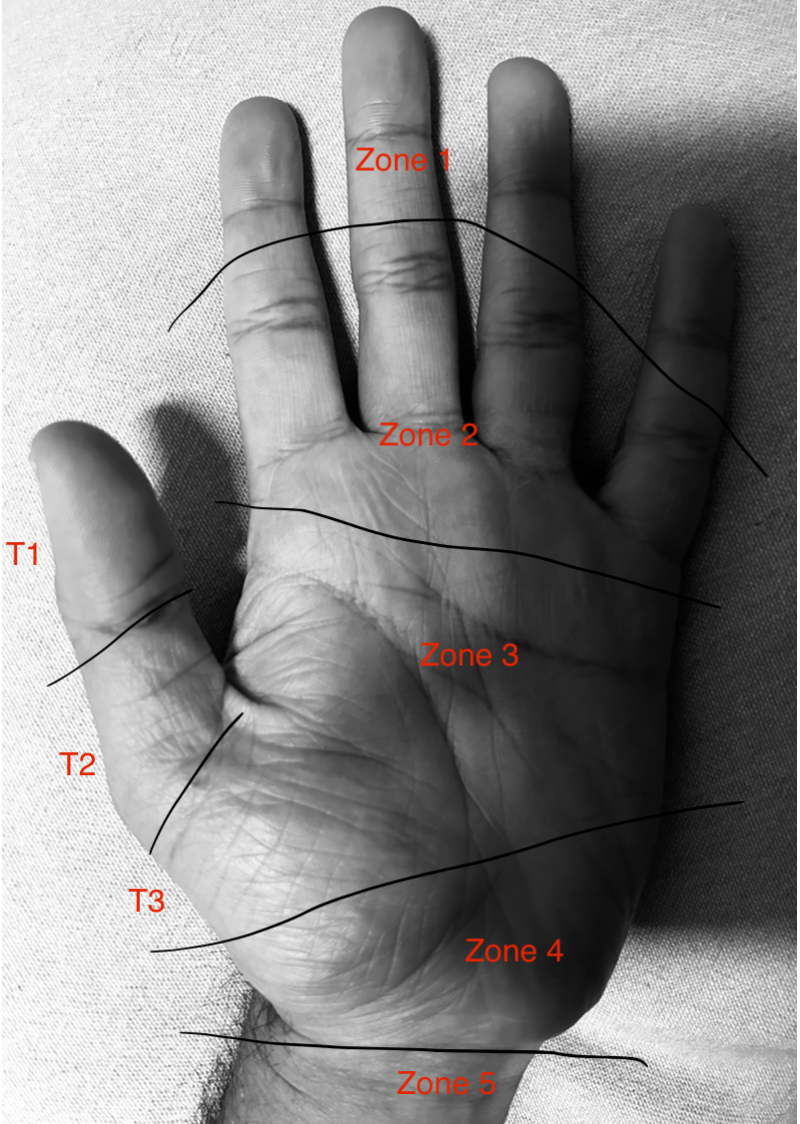Kitchen Nightmares
Author: Swami Rajaram, MD
Peer-Reviewer: Jeremy Swisher, MD
Final Editor: Alex Tomesch, MD, CAQ-SM
A 44-year-old male presents with a left finger laceration sustained while cutting vegetables. He is right-hand dominant and up-to-date on his tetanus. On exam, there is a 3 cm zone 2 laceration across the base of the left pointer finger. The patient is unable to flex the affected digit at both the DIP and PIP joints. He endorses diminished sensation to the distal fingertip. He has good capillary refill and no evidence of arterial bleeding.

Image 1. Plain radiograph of the left hand. Case courtesy of Andrew Murphy, Radiopaedia.org, rID: 48226

Image 2. Anatomical zones of the hand. Author’s own images
What is the diagnosis?
The patient is presenting with signs and symptoms of a complete flexor tendon injury.
-
Pearl: Flexor tendon injuries most commonly occur due to lacerations. Work-related trauma accounts for up to 25% of all cases, with construction and food preparation employees at the highest risk for injury [4]. Flexor tendon injuries have a higher prevalence in zones II-V and will be more common in the 2nd and 5th digits [6].
What is the mechanism of injury?
There are two flexor tendons for each digit, the flexor digitorum profundus (FDP) and flexor digitorum superficialis (FDS). One or both of these flexor tendons may be affected depending on where the laceration is located [5]. Flexor pollicis longus flexes the thumb IP joint.
-
Pearl: The FDS tendon controls PIP flexion, while the FDP tendon controls DIP flexion.
-
Pearl: Both flexor tendons are present in Zone II - V. Only the FDP is present in Zone I (5).
What physical exam findings are expected?
Injury to a flexor tendon causes the affected finger to be out of cascade and in an extended position. Loss of digit flexion is suggestive of complete tendon transection, while painful digit flexion is suggestive of a partial injury [7].
-
Pearl: The DIP and PIP joints for suspected flexor injury should be tested in isolation.
-
Pearl: The digit nerves and arteries run close to the tendon - remember to always assess neurovascular status. This includes two-point discrimination and capillary refill tests [5].
Which imaging modalities can be used?
Diagnosis is clinical. Plain films can be useful adjuncts to evaluate for foreign bodies or underlying fractures. Point-of-care ultrasound can be utilized to assess the integrity of the tendons with high sensitivity and specificity [1].
What is the management in the ED?
Flexor tendon lacerations require a delicate and precise approach for repair and should be performed urgently by a hand surgeon. In the interim, the ER physician should thoroughly irrigate the wound, provide appropriate tetanus coverage, and loosely repair the overlying laceration with non-absorbable sutures. The injured extremity should be stabilized with a dorsal slab splint to relieve additional tension placed on the damaged tendons.
-
Pearl: Prophylactic antibiotics are typically given, though research has not demonstrated a true benefit in preventing wound infections. Cephalexin 500 mg every 6 hours for 5 - 7 days is a typical antibiotic regimen [3].
-
Pearl: The dorsal slab splint should aim to have the wrist in 30 degrees flexion, MCP in 70 degree flexion, and IP joints in 10 degrees flexion.
When do you consult orthopedics?
This largely depends on local clinical practices, but all suspected flexor tendon injury cases should be discussed with a hand surgeon to arrange for urgent repair. A tendon injury complicated by an open fracture or arterial injury warrants emergent hand surgery consultation.
References
[1] Bekhet CNH, Ghaffar MKA, Nassef MA, Khattab RT. Role of Ultrasound in Flexor Tendon Injuries of the Hand: A New Insight. Ultrasound Med Biol. 2021;47(8):2157-2166.
[2] Elliot D. Secondary surgery of the flexor tendons. Indian J Plast Surg. 2005;38:9–15.
[3] Grossman JAI, Adams JP, Kunec J. Prophylactic Antibiotics in Simple Hand Lacerations. 1981;245(10):1055–1056. doi:10.1001/jama.1981.03310350043021
[4] de Jong JP, Nguyen JT, Sonnema AJ, et al. The incidence of acute traumatic tendon injuries in the hand and wrist: a 10-year population-based study. Clinics in orthopedic surgery. 2014;6:196–202.
[5] Sabapathy S.R., Bhardwaj P. Tendon injuries. In: Sivananthan S., Sherry E., Warnke P., Miller M.D., editors. Mercer's Text Book of Orthopaedics and Trauma. Hodder Arnold; 2012. pp. 1292–1301.
[6] Stevens KA, Caruso JC, Fallahi AKM, et al. Flexor Tendon Lacerations. [Updated 2023 Jun 20]. In: StatPearls [Internet]. Treasure Island (FL): StatPearls Publishing; 2023 Jan-.
[7] Venkatramani H, Varadharajan V, Bhardwaj P, Vallurupalli A, Sabapathy SR. Flexor tendon injuries. J Clin Orthop Trauma. 2019;10(5):853-861. doi:10.1016/j.jcot.2019.08.005


